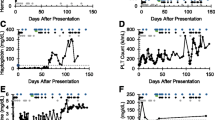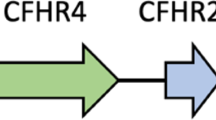Abstract
Background
Thrombotic microangiopathy (TMA) is usually caused due to dysregulation of the alternative complement pathway. Rarely, thrombotic microangiopathy is caused by non-complement mediated mutations in diacylglycerol kinase epsilon (DGKE); information about therapy and outcome of these patients is limited.
Methods
Medical records of patients, younger than 18 years, diagnosed with TMA and variants in DGKE were reviewed to include 12 patients from seven centers. Genetic studies included targeted exome sequencing and multiplex-ligation dependent probe amplification of CFH-CFHR5.
Results
Patients presented at a median age of 11 (7.5, 12.3) months; all were younger than 2 years. All patients had an infectious prodrome; enteroinvasive, enteropathogenic, and enterotoxigenic Escherichia coli were detected in two patients with diarrhea. Chief features included those of microangiopathic hemolysis (n = 11), microscopic hematuria (n = 10), nephrotic range proteinuria (n = 10), hypoalbuminemia (n = 6), elevated total cholesterol (n = 6), and hypocomplementemia (n = 4). Histopathology showed thrombotic microangiopathy (n = 4), overlapping with membranoproliferative pattern of injury (n = 1). At median 3.3 years of follow-up, significant hypertension and/or proteinuria (40%), relapses (66.7%), and death or progression to CKD (60%) were common. Genetic sequencing showed 13 homozygous and compound heterozygous variants (7 pathogenic, 3 likely pathogenic) located throughout DGKE; 11 variants were novel.
Conclusions
This case series highlights the need to suspect DGKE nephropathy in young patients with TMA, especially those with severe proteinuria. Medium-term outcomes are unsatisfactory with risk of relapses, progressive kidney failure, and death.
Graphical abstract

A higher resolution version of the Graphical abstract is available as Supplementary information

Similar content being viewed by others
References
Michael M, Bagga A, Sartain SE, Smith RJH (2022) Haemolytic uraemic syndrome. Lancet 400:1722–1740
Fakhouri F, Fremeaux-Bacchi V (2021) Thrombotic microangiopathy in aHUS and beyond: clinical clues from complement genetics. Nat Rev Nephrol 17:543–553
Sinha A, Gulati A, Saini S, Blanc C, Gupta A, Gurjar BS, Saini H, Kotresh ST, Ali U, Bhatia D, Ohri A, Kumar M, Agarwal I, Gulati S, Anand K, Vijayakumar M, Sinha R, Sethi S, Salmona M, George A, Bal V, Singh G, Dinda AK, Hari P, Rath S, Dragon-Durey MA, Bagga A; Indian HUS Registry (2014) Prompt plasma exchanges and immunosuppressive treatment improves the outcomes of anti-factor H autoantibody-associated hemolytic uremic syndrome in children. Kidney Int 85:1151–1160
Lemaire M, Fremeaux-Bacchi V, Schaefer F, Choi M, Tang WH, Le Quintrec M, Fakhouri F, Taque S, Nobili F, Martinez F, Ji W, Overton JD, Mane SM, Nurnberg G, Altmuller J, Thiele H, Morin D, Deschenes G, Baudouin V, Llanas B, Collard L, Majid MA, Simkova E, Nurnberg P, Rioux-Leclerc N, Moeckel GW, Gubler MC, Hwa J, Loirat C, Lifton RP (2013) Recessive mutations in DGKE cause atypical hemolytic-uremic syndrome. Nat Genet 45:531–536
Brocklebank V, Kumar G, Howie AJ, Chandar J, Milford DV, Craze J, Evans J, Finlay E, Freundlich M, Gale DP, Inward C, Mraz M, Jones C, Wong W, Marks SD, Connolly J, Corner BM, Smith-Jackson K, Walsh PR, Marchbank KJ, Harris CL, Wilson V, Wong EKS, Malina M, Johnson S, Sheerin NS, Kavanagh D (2020) Long-term outcomes and response to treatment in diacylglycerol kinase epsilon nephropathy. Kidney Int 97:1260–1274
Azukaitis K, Simkova E, Majid MA, Galiano M, Benz K, Amann K, Bockmeyer C, Gajjar R, Meyers KE, Cheong HI, Lange-Sperandio B, Jungraithmayr T, Fremeaux-Bacchi V, Bergmann C, Bereczki C, Miklaszewska M, Csuka D, Prohaszka Z, Killen P, Gipson P, Sampson MG, Lemaire M, Schaefer F (2017) The phenotypic spectrum of nephropathies associated with mutations in diacylglycerol kinase epsilon. J Am Soc Nephrol 28:3066–3075
Sanchez Chinchilla D, Pinto S, Hoppe B, Adragna M, Lopez L, Justa Roldan ML, Pena A, Lopez Trascasa M, Sanchez-Corral P, Rodriguez de Cordoba S (2014) Complement mutations in diacylglycerol kinase-epsilon-associated atypical hemolytic uremic syndrome. Clin J Am Soc Nephrol 9:1611–1619
Ozaltin F, Li B, Rauhauser A, An SW, Soylemezoglu O, Gonul II, Taskiran EZ, Ibsirlioglu T, Korkmaz E, Bilginer Y, Duzova A, Ozen S, Topaloglu R, Besbas N, Ashraf S, Du Y, Liang C, Chen P, Lu D, Vadnagara K, Arbuckle S, Lewis D, Wakeland B, Quigg RJ, Ransom RF, Wakeland EK, Topham MK, Bazan NG, Mohan C, Hildebrandt F, Bakkaloglu A, Huang CL, Attanasio M (2013) DGKE variants cause a glomerular microangiopathy that mimics membranoproliferative GN. J Am Soc Nephrol 24:377–384
Flynn JT, Kaelber DC, Baker-Smith CM, Blowey D, Carroll AE, Daniels SR, de Ferranti SD, Dionne JM, Falkner B, Flinn SK, Gidding SS, Goodwin C, Leu MG, Powers ME, Rea C, Samuels J, Simasek M, Thaker VV, Urbina EM, Subcommittee on screening and management of high blood pressure in children (2017) Clinical practice guideline for screening and management of high blood pressure in children and adolescents. Pediatrics 140:e20171904
Puraswani M, Khandelwal P, Saini H, Saini S, Gurjar BS, Sinha A, Shende RP, Maiti TK, Singh AK, Kanga U, Ali U, Agarwal I, Anand K, Prasad N, Rajendran P, Sinha R, Vasudevan A, Saxena A, Agarwal S, Hari P, Sahu A, Rath S, Bagga A (2019) Clinical and immunological profile of anti-factor H antibody associated atypical hemolytic uremic syndrome: a nationwide database. Front Immunol 10:1282
Richards S, Aziz N, Bale S, Bick D, Das S, Gastier-Foster J, Grody WW, Hegde M, Lyon E, Spector E, Voelkerding K, Rehm HL; ACMG Laboratory Quality Assurance Committee (2015) Standards and guidelines for the interpretation of sequence variants: a joint consensus recommendation of the American College of Medical Genetics and Genomics and the Association for Molecular Pathology. Genet Med 17:405–424
Bharathy PS, Krishnamurthy S, Archana A, Karunakar P, Deepthi B, Srinivas BH (2021) Nephrotic syndrome in a 7-year-old girl with atypical hemolytic uremic syndrome relapse: answers. Pediatr Nephrol 36:843–847
Sharma J, Lobo V, Singhal J, Anand S, Kadam S, Ranade S, Gangodkar P, Ganesan K, Phadke N, Agarwal M (2021) Novel mutations in the DGKE gene in two Indian patients with early-onset atypical haemolytic uraemic syndrome. Indian J Nephrol 31:182–186
Sharma A, Yadav M, Sethi S, Hari P, Sinha A, Bagga A (2019) Atypical hemolytic uremic syndrome with diacylglycerol kinase epsilon (DGKE) gene mutation. Asian J Pediatr Nephrol 2:101–103
Kopanos C, Tsiolkas V, Kouris A, Chapple CE, Albarca Aguilera M, Meyer R, Massouras A (2019) VarSome: the human genomic variant search engine. Bioinformatics 35:1978–1980
Bruneau S, Neel M, Roumenina LT, Frimat M, Laurent L, Fremeaux-Bacchi V, Fakhouri F (2015) Loss of DGKepsilon induces endothelial cell activation and death independently of complement activation. Blood 125:1038–1046
Noris M, Mele C, Remuzzi G (2015) Podocyte dysfunction in atypical haemolytic uraemic syndrome. Nat Rev Nephrol 11:245–252
Westland R, Bodria M, Carrea A, Lata S, Scolari F, Fremeaux-Bacchi V, D’Agati VD, Lifton RP, Gharavi AG, Ghiggeri GM, Sanna-Cherchi S (2014) Phenotypic expansion of DGKE-associated diseases. J Am Soc Nephrol 25:1408–1414
Rodriguez de Turco EB, Tang W, Topham MK, Sakane F, Marcheselli VL, Chen C, Taketomi A, Prescott SM, Bazan NG (2001) Diacylglycerol kinase epsilon regulates seizure susceptibility and long-term potentiation through arachidonoyl-inositol lipid signaling. Proc Natl Acad Sci U S A 98:4740–4745
de Holanda MI, Gomes CP, Araujo SA, Wanderley DC, Eick RG, Dantas GC, Tino M, Pesquero JB, Palma LMP (2019) Diacylglycerol kinase epsilon nephropathy: late diagnosis and therapeutic implications. Clin Kidney J 12:641–644
Besbas N, Gulhan B, Soylemezoglu O, Ozcakar ZB, Korkmaz E, Hayran M, Ozaltin F (2017) Turkish pediatric atypical hemolytic uremic syndrome registry: initial analysis of 146 patients. BMC Nephrol 18:6
Fu W, Li M, Lin H, Xu Y, Han W, Chen H, Sun L (2021) Cyclosporine A relieved proteinuria and hypoproteinemia in DGKE nephropathy. Clin Chim Acta 518:78–82
Funding
Funding support by the Indian Council of Medical Research (Advanced Center for Research in Pediatric Kidney Diseases; 5/7/1090/2013-RHN and 5/4/7–18/Nephro/2020-NCDII).
Author information
Authors and Affiliations
Corresponding author
Ethics declarations
Conflict of interest
The authors declare no competing interests.
Additional information
Publisher's note
Springer Nature remains neutral with regard to jurisdictional claims in published maps and institutional affiliations.
Supplementary information
Below is the link to the electronic supplementary material.
Rights and permissions
Springer Nature or its licensor (e.g. a society or other partner) holds exclusive rights to this article under a publishing agreement with the author(s) or other rightsholder(s); author self-archiving of the accepted manuscript version of this article is solely governed by the terms of such publishing agreement and applicable law.
About this article
Cite this article
Khandelwal, P., Thangaraju, S., Krishnamurthy, S. et al. Clinical features and outcomes of patients with diacylglycerol kinase epsilon nephropathy: a nationwide experience. Pediatr Nephrol 38, 3009–3016 (2023). https://doi.org/10.1007/s00467-023-05939-5
Received:
Revised:
Accepted:
Published:
Issue Date:
DOI: https://doi.org/10.1007/s00467-023-05939-5




